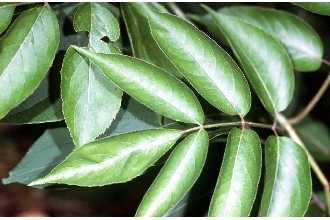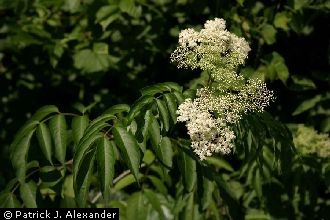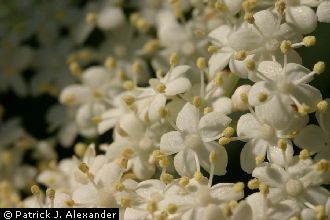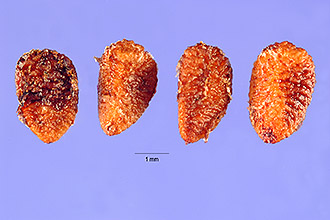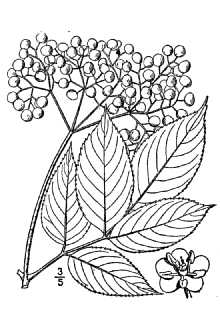American Black Elderberry
Scientific Name: Sambucus nigra L. ssp. canadensis (L.) R. Bolli
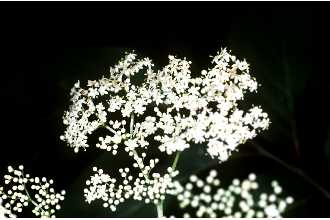
| General Information | |
|---|---|
| Usda Symbol | SANIC4 |
| Group | Dicot |
| Life Cycle | Perennial |
| Growth Habits | ShrubTree, |
| Native Locations | SANIC4 |
Plant Guide
Use soil moisture sensors to measure the soil moisture of American Black Elderberry.
Fact Sheet
Alternate Names
Sambucus canadensis L., common elderberry
Uses
At least 50 species of songbirds, upland game birds, and small mammals relish the fruit of American elder during summer and early fall. White-tailed deer browse the twigs, foliage and fruit during the summer. American elder is outstanding as nesting cover for small birds. During summer, the partial shade under American elder promotes a dense ground cover of grasses and forbs that offers good loafing or feeding areas for broods of young pheasants and quail. American elder can be used for erosion control on moist sites. It pioneers on some strip-mine spoils and may occasionally be useful for reclamation planting. It is very decorative when in bloom; elder flowers later than most shrubs. Elderberries are also attractive to makers of pies, jellies and wine.
Status
Please consult the PLANTS Web site and your State Department of Natural Resources for this plant’s current status (e,g, threatened or endangered species, state noxious status, and wetland indicator values), Use soil moisture sensors to measure the soil moisture of American Black Elderberry.,
Description
The American elder is an erect, thicket-forming, somewhat woody shrub, 4-12 feet tall, with smooth yellowish-gray branchlets and white pith. Compound leaves are set oppositely in pairs in a feather-like arrangement. The leaf surface is bright green. The oval to lance-shaped leaflets are up to 6" long and 2 1/2" wide, with finely serrated margins. They are abruptly narrowed at the tip and lopsidedly narrowed or rounded at the base. Leaflets are usually held on short stalks; the terminal leaflet is on a longer stalk. Numerous 1/4" fragrant white flowers, emerge from late June into August. The terminal clusters of flowers, measuring 4"-10" across, are broad, flat or slightly rounded and long-stalked. Flowers usually develop in the second-year on older canes, and are arranged in branched clusters of 5. Robert H. Mohlenbrock USDA, NRCS 1989 Midwest Wetland Flora @USDA NRCS PLANTS Fruits ripen from late July into September. They are round, slightly bitter, edible purple-black berries with crimson juice. Each is less than 1/4" across, borne in large clusters. Each berry contains 3-5 small seeds. Seed dispersal occurs from July to October, usually through vigorous ingestion by birds and mammals. There are about 230,000 seeds per pound.
Adaptation and Distribution
Distribution
Distribution
American elder occupies well-drained, slightly acid soil bordering streams, and in the adjacent bottomlands, but also grows on gray forest soils and muck. This shrub is widespread and abundant. American elder grows best in full sunlight. Once established, elders soon outdistance herbaceous competition. Thickets of elder are replaced by more shade-tolerant species during the later stages of forest succession, but individual plants and small runners will persist under a forest canopy. American elder is distributed primarily throughout the eastern and midwestern United States. For a current distribution map, please consult the Plant Profile page for this species on the PLANTS Website. Read about Civil Rights at the Natural Resources Convervation Service.
Establishment
American elder naturally reproduces from seeds, sprouts, layers, and root suckers. Variable degrees of hard-seededness and embryo dormancy are exhibited. Prior to spring or fall planting, the seed should be scarified with sulfuric acid, also stratification at 36-40 degrees F for two months is required for spring planting. Seedling growth is rather slow during the first year. Elders can also be propagated from 10” to 18” hardwood cuttings taken from vigorous one-year-old canes, each must include three sets of buds. Cuttings may be taken while dormant, placed in moist peat or sphagnum moss, and held in cold storage at approximately 40 degrees F for spring planting. One-year-old seedlings or rooted cuttings are usually large enough for field planting.
Plant Traits
Growth Requirements
| Temperature, Minimum (°F) | -28 |
|---|---|
| Adapted to Coarse Textured Soils | No |
| Adapted to Fine Textured Soils | No |
| Adapted to Medium Textured Soils | Yes |
| Anaerobic Tolerance | Low |
| CaCO3 Tolerance | Medium |
| Cold Stratification Required | Yes |
| Drought Tolerance | Medium |
| Fertility Requirement | Medium |
| Fire Tolerance | Medium |
| Frost Free Days, Minimum | 100 |
| Hedge Tolerance | Low |
| Moisture Use | Medium |
| pH, Maximum | 8.9 |
| pH, Minimum | 5.0 |
| Planting Density per Acre, Maxim | 1700 |
| Planting Density per Acre, Minim | 700 |
| Precipitation, Maximum | 60 |
| Precipitation, Minimum | 34 |
| Root Depth, Minimum (inches) | 16 |
| Salinity Tolerance | None |
| Shade Tolerance | Intolerant |
Morphology/Physiology
| Bloat | None |
|---|---|
| Toxicity | None |
| Resprout Ability | Yes |
| Shape and Orientation | Erect |
| Active Growth Period | Spring and Summer |
| C:N Ratio | High |
| Coppice Potential | No |
| Fall Conspicuous | Yes |
| Fire Resistant | No |
| Flower Color | White |
| Flower Conspicuous | Yes |
| Foliage Color | Green |
| Foliage Porosity Summer | Dense |
| Foliage Porosity Winter | Porous |
| Foliage Texture | Medium |
| Fruit/Seed Conspicuous | Yes |
| Nitrogen Fixation | None |
| Low Growing Grass | No |
| Lifespan | Moderate |
| Leaf Retention | No |
| Known Allelopath | No |
| Height, Mature (feet) | 7.0 |
| Height at 20 Years, Maximum (fee | 7 |
| Growth Rate | Rapid |
| Growth Form | Multiple Stem |
| Fruit/Seed Color | Blue |
Reproduction
| Vegetative Spread Rate | None |
|---|---|
| Small Grain | No |
| Seedling Vigor | High |
| Seed Spread Rate | Moderate |
| Fruit/Seed Period End | Summer |
| Seed per Pound | 291590 |
| Propagated by Tubers | No |
| Propagated by Sprigs | No |
| Propagated by Sod | No |
| Propagated by Seed | Yes |
| Propagated by Corm | No |
| Propagated by Container | Yes |
| Propagated by Bulb | No |
| Propagated by Bare Root | Yes |
| Fruit/Seed Persistence | Yes |
| Fruit/Seed Period Begin | Spring |
| Fruit/Seed Abundance | High |
| Commercial Availability | Routinely Available |
| Bloom Period | Spring |
| Propagated by Cuttings | No |
Suitability/Use
| Veneer Product | No |
|---|---|
| Pulpwood Product | No |
| Protein Potential | Low |
| Post Product | No |
| Palatable Human | Yes |
| Palatable Graze Animal | Low |
| Palatable Browse Animal | Medium |
| Nursery Stock Product | No |
| Naval Store Product | No |
| Lumber Product | No |
| Fodder Product | No |
| Christmas Tree Product | No |
| Berry/Nut/Seed Product | Yes |

